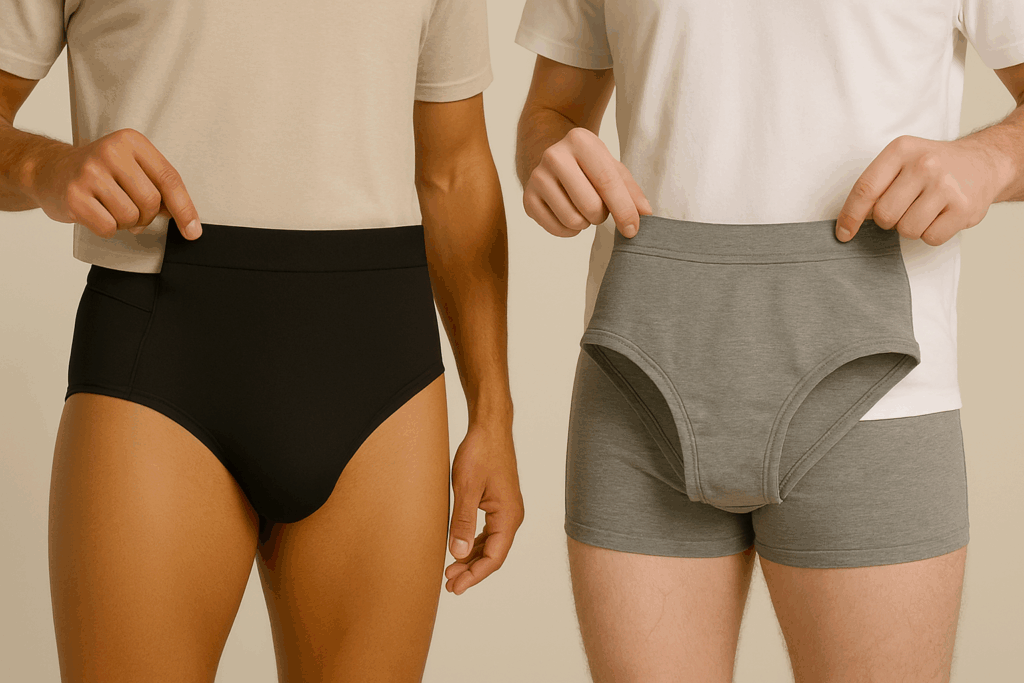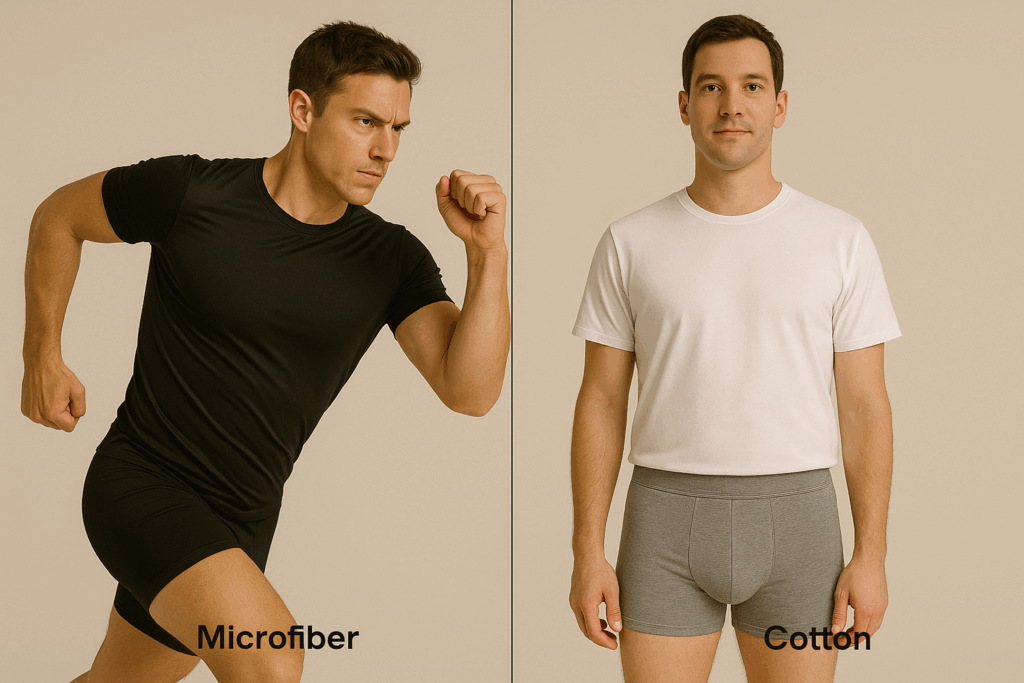Choosing the right underwear fabric can feel more complicated than it should be. Between microfiber and cotton, there’s a lot to consider — comfort, breathability, durability, and even environmental impact. So, which fabric suits your needs best? Let’s break it all down in a straightforward way, backed by scientific insights and practical advice. You might even find out something surprising along the way!

Understanding the Basic Differences Between Microfiber and Cotton Underwear
Before diving into comfort and performance, it’s essential to grasp what sets microfiber and cotton apart at their core.
What microfiber fabric is and its defining characteristics
Microfiber is a synthetic fabric made of extremely fine fibers — usually polyester or nylon blends — that are thinner than a human hair. Because the fibers are so tiny, they create a fabric that is smooth, lightweight, and highly flexible. This gives microfiber underwear a silky texture and excellent stretchability, ideal for a snug but comfortable fit.
Microfiber is also engineered to wick moisture away from the skin quickly, keeping you dry and cool. Plus, it resists wrinkling and shrinking, which means your underwear maintains its shape longer. On the flip side, microfiber isn’t as breathable as natural fabrics, which can be a drawback for some [1][2].
Essential properties and natural benefits of cotton fabric
Cotton, on the other hand, is a natural fiber harvested from cotton plants. It’s loved for its softness, breathability, and hypoallergenic qualities. Because of the way cotton fibers are structured, they absorb moisture rather than wick it away. This means cotton underwear feels gentle against the skin and reduces irritation, especially for people with sensitive skin or allergies.
However, cotton tends to hold onto moisture longer, which might lead to discomfort during heavy sweating or intense activity. While cotton is durable, it can shrink or wear out faster compared to some synthetics if not properly cared for [3][4].
How microfiber and cotton differ in physical feel and comfort
If you’ve ever worn a microfiber garment, you probably noticed the sleek, almost satiny feel—it’s light, smooth, and sometimes even a little cool to the touch. Cotton, in contrast, has a natural, matte finish and a plush softness that feels cozy and familiar.
Comfort-wise, microfiber’s quick-drying properties make it great for keeping sweat away, so ideal for workouts or warm weather. Cotton provides that breathable, natural comfort perfect for everyday lounging. The choice ultimately boils down to what your skin prefers and how often you’re active [5].
Transitioning from the basics, the real game-changer is how these fabrics perform when you’re wearing them all day — especially concerning comfort and breathability.
Comparing Comfort and Breathability for Everyday Use
When it comes to underwear, comfort isn’t just about how it feels but also about how it handles moisture and airflow. Let’s see how these two fabrics stack up.
The moisture-wicking and cooling effects of microfiber underwear
One of microfiber’s biggest perks is its moisture-wicking ability. It pulls sweat away from your skin to the fabric’s surface, where it evaporates quickly. This helps reduce sticky, uncomfortable feelings and keeps you cooler, especially during exercise or hot weather [6].
Plus, microfiber’s tight weave creates a lightweight barrier that doesn’t absorb much water, so your underwear dries faster after washing or sweating. This technology is why microfiber is popular in activewear and sports underwear. It also minimizes chafing in sensitive areas by reducing trapped moisture [7].
Breathability, softness, and skin feel of cotton underwear
Cotton wins hands-down for breathability. Because the fibers are naturally porous, air circulates easily, helping to keep your skin cool and dry. This is a huge plus if you have sensitive skin or prefer a fabric that lets your skin “breathe.”
The softness of cotton is another factor — it feels natural and comforting against the skin. That said, cotton does absorb sweat rather than wick it away, which means it can sometimes feel damp during intense activity [8]. Still, for everyday wear, cotton is a reliable choice to prevent skin irritation and allergies.
Suitability of each fabric for sensitive skin and allergy concerns
People with sensitive skin often swear by cotton due to its hypoallergenic properties. Cotton generally doesn’t irritate, making it ideal for those prone to rashes or eczema.
Microfiber, despite being synthetic, can also be gentle on skin thanks to its smooth surface reducing friction, but some may find it less breathable or experience sensitivities due to the synthetic fibers themselves [9]. If allergies are a concern, testing small patches or opting for cotton might be a safer bet.
Alright, now that we have comfort and breathability covered, let’s talk about another big factor in your underwear’s lifespan: care and durability.
Durability, Care, and Practicality of Microfiber and Cotton Underwear
How long your underwear lasts depends on how you care for it—and the fabric’s innate durability.
Best practices for washing and maintaining microfiber underwear
Microfiber garments require gentle care to maintain their performance. Washing with mild detergent, avoiding bleach, and using cold water preserves the fibers. Skip fabric softeners—they can clog up the fibers and reduce moisture-wicking ability [10].
Microfiber dries quickly and resists shrinking, so air drying is ideal. If you must machine dry, use low heat. Proper care means microfiber underwear can last a long time, keeping its shape and comfort intact [11].
Longevity and care tips to extend the life of cotton underwear
Cotton tends to shrink after the first few washes and is vulnerable to wear and tear if not cared for. Use cold water to wash, avoid harsh detergents, and skip bleach. Air drying is the best, but a low-heat tumble dry is usually safe [12].
Pilling and fabric thinning can happen over time, especially for cheaper cotton, so investing in higher quality cotton underwear pays off. Also, cotton loses some softness after repeated washing but remains breathable and comfortable for daily use.
Evaluating cost and everyday practicality when choosing fabrics
Cost-wise, cotton underwear is generally more affordable and readily available. Microfiber underwear can be pricier due to manufacturing complexities and often being marketed as performance wear.
Practically speaking, microfiber underwear is excellent for active men or those living in hot climates needing moisture control. Cotton is perfect for everyday comfort and people who prioritize natural, breathable fabrics.
So, what about specific activities and climates? Let’s dive into that next.
Choosing the Right Underwear Fabric for Different Activities and Climates
The fabric you choose should complement your lifestyle and environment.

Why microfiber excels in sports and active lifestyles
For athletes or those who exercise regularly, microfiber is the go-to fabric. Its moisture-wicking and quick-dry functions keep sweat away during intense workouts, reducing the risk of chafing or skin irritation.
Microfiber also offers a snug fit that supports without restriction, making it perfect under workout gear or during outdoor activities where you want maximum comfort and dryness [13].
The comfort advantages of cotton for casual, daily wear
Cotton underwear is the classic choice for casual, everyday wear. It’s soft and breathable, allowing the skin to stay cool and minimizing irritation. If your day involves little heavy sweating and more office or home time, cotton keeps you comfortable all day.
Cotton’s natural feel can also boost your mood, providing the simple comfort of natural fibers, especially in cooler environments [14].
How seasonal and climate factors influence fabric choice
Hot, humid climates favor microfiber’s moisture control and quick drying properties to prevent discomfort and sweating. In contrast, cooler seasons or air-conditioned environments often call for cotton’s warmth and breathability, which feels snug but not sweaty.
If you live somewhere with marked seasonal changes, consider having both types in your wardrobe to switch based on weather and activity.
Almost forgot — there is a growing awareness about sustainability that can influence your choice. Let’s talk about that.
Environmental and Sustainability Considerations When Choosing Fabric
We all want underwear that’s good for us and the planet.
Understanding the environmental impact of microfiber and synthetic materials
Microfiber fabrics, being synthetic, derive from petroleum products and contribute to microplastic pollution. When laundering microfiber clothes, tiny fibers often break off and enter waterways, causing ecological harm [15].
While performance benefits are undeniable, these environmental consequences should be considered, especially if you’re committed to reducing plastic waste.
Sustainability issues linked to organic and conventional cotton production
Cotton’s sustainability varies greatly depending on farming practices. Conventional cotton uses significant water and toxic pesticides, which have environmental and health repercussions. Organic cotton reduces these impacts but may come with a higher price tag [16].
Choosing organic or sustainably sourced cotton is a way to enjoy natural comfort while supporting eco-friendly practices.
Guidelines for making an eco-friendly decision between microfiber and cotton
If sustainability is a priority:
- Opt for organic cotton or brands committed to ethical production
- Limit microfiber use or select fabrics blended with recycled plastics
- Wash synthetics in a microfiber-catching laundry bag to reduce fiber release
- Rotate fabrics and care for garments to extend lifespan, reducing waste [17]
Balancing personal comfort and environmental impact helps create a wardrobe that’s thoughtful and practical.
Conclusion: Which Fabric is Best Suited for Your Underwear Needs?
Now, let’s round it all up with a fair look at both fabrics.
A balanced summary of the strengths and weaknesses of microfiber and cotton
Microfiber underwear offers superior moisture control, durability, and a lightweight, smooth feel — perfect for athletes and hot climates. However, it has environmental drawbacks and can be less breathable for sensitive skin.
Cotton underwear provides unmatched breathability, softness, and hypoallergenic properties that make it ideal for daily casual wear and cooler environments. Its environmental impact depends heavily on the cultivation method.
How personal preferences and lifestyle factors should guide your choice
Consider these questions:
- Are you frequently active and sweaty? Microfiber is your best friend.
- Do you have sensitive skin or prefer natural fibers? Cotton is the way to go.
- Is sustainability a big concern? Prioritize organic cotton or reduce microfiber use.
- What’s your climate like? Hot weather might lean you towards microfiber, cool towards cotton.
Ultimately, having both fabric types available allows you to tailor your underwear choice to your day-to-day needs and values. Comfort, performance, and environmental mindfulness can all coexist — it’s just about finding the right balance for you.
